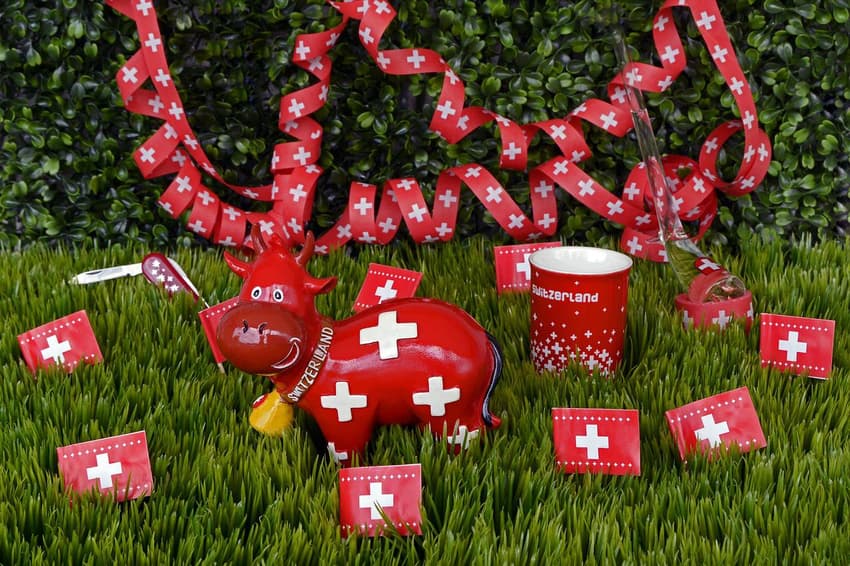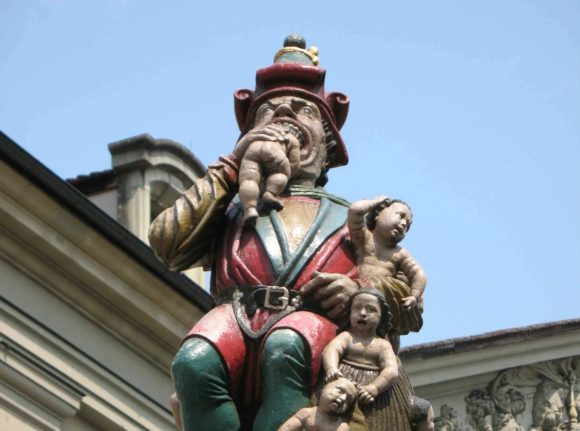From ogres to hermits: 11 weird facts that show Switzerland is truly unique

With Swiss National Day upon us on August 1st, this is a good time to explore some unusual and fascinating - though perhaps not widely known - facts about Switzerland.
The mere mention of August 1st likely conjures up images of the beautiful Rütli meadow, where Switzerland’s foundations were reportedly laid in 1291.
This was when representatives from Uri, Schwyz and Nidwalden signed the Federal Charter promising to “assist each other by every means possible against one and all who may inflict on them violence or injustice within their valleys and without”.
And the rest, as the saying goes, is history.
However, beyond this story that defines the beginnings of Switzerland, there are other, though lesser known, historical and cultural aspects of this country’s past and present that are worth looking at as the country celebrates its 731st birthday.
Here’s a compilation of some curious, unusual and interesting facts, as well as typically Swiss quirks and oddities.
Switzerland has a pyramid
Everyone knows that Alps occur naturally in Switzerland, but you don't expect to find a pyramid here.
While it is not at all like its namesakes in Egypt — for one, it is a wonder of nature rather than man-made — the Swiss pyramid, called the Niesen, forms a perfectly geometric peak.
Unattached to other mountains in the Bernese Alps where it lives, it stands alone, scenically overlooking the Thun Lake. You can see it here.
Satanic chicken
According to a book titled “A Pilgrim’s Almanac”, in 1471 a chicken in Basel laid a colourful egg.
The townsfolk immediately accused the poor bird of being possessed by the devil and burned it at the stake (that was before barbecues were invented).
Is this how the term ‘devilled eggs’ originate? We are not sure.
Fish with rights
Fast-forward to the 21st century and various animal welfare laws.
In fact, a Zurich lawyer, Antoine Goetschel, dedicated his career to defending animal rights in court.
He made headlines in 2010, when he represented a 22-pound pike that he claimed suffered when a local fisherman roughly yanked it for 10 minutes before pulling it from icy waters of Lake Zurich.

Fishing for trouble? Photo: Pexels
Lobsters with rights
By the same token, in 2018 Switzerland passed a law making it illegal to boil a live lobster, deeming this practice cruel, as lobsters apparently feel pain.
Instead, this legislation, the first of its kind in the world, calls for a more humane death by “rendering lobsters unconscious” before tossing them into scalding water.
Monkeys with rights
Alright, so it might appear a trend is emerging here, but in 2022 the Swiss canton of Basel City went to the polls to vote on a referendum topic to give primates rights.
Voters however were not monkeying around, dismissing the idea by a 75 percent majority.
Bern ogre
As The Local reported, Switzerland’s capital city has a scary Kindlifresserbrunnen, which translates literally as the Fountain of the Eater of Little Children.
"Perhaps even more concerning is that nobody knows much about the statue, least of all why it’s eating a naked baby – and presumably planning on eating a few more out of the bulging sack".
There are several theories which attempt to explain what the statue is actually supposed to represent. Some are kooky, while others are incredibly problematic.
A major theory is that the statue is a representation of the Krampus, a mythical creature across much of German-speaking Europe who comes out at Christmas time to punish the kids that have been misbehaving – although we’re not exactly sure how a kid is supposed to learn his or her lesson by being eaten.

There's trouble in Bern. Photo: Mike Lehmann - Wikicommons, CC BY-SA 3.0
READ MORE : The Swiss capital Bern has a statue of an ogre eating babies and nobody knows why
A woman town crier
After over 600 years of night watchmen, a woman’s voice now resounds loud and clear over Lausanne.
Since she was hired for the job in August 2021, the watchwoman has been announcing the hours every night between 10 pm and 2 am from the bell tower of the city’s imposing Gothic cathedral, a landmark overlooking the roofs of the picturesque Old Town.
READ MORE: After 600 years of night watchmen, Lausanne gets first watchwoman
‘Bünzli’
The term Bünzli is a Swiss-German insult to describe a particular type of person who is set in their ways, is narrow-minded and tries desperately hard to hang onto tradition.
They are fussy, fastidious, stodgy, and invariably dull rule- sticklers.
Curiously enough, there are no equivalent characters in the French or Italian part of Switzerland — make of it what you will.
This article describes in more detail what a Bünzli is:
Reader question: What is Switzerland’s ‘Bünzli’ and how do I spot one?
Not a Bünzli, but a hermit
In 2016, the town of Solothurn advertised a job vacancy for a hermit to live a solitary existence in a secluded cave-like cabin near a gorge.
His job description : take care of nearby chapel and dispense wisdom to tourists.
Former policeman Michael Daum snagged the position that has existed since the 15th century. By all accounts, he is not a Bünzli.
Love of cow bells church clocks
The Swiss have a special fondness for hearing the sound of cow bells and chiming of church clocks in the tower — no matter how loud, how frequent, and how late at night.
People — who often just happen to be foreigners — complaining about the lack of sleep due to incessant noise are ostracised and denied Swiss citizenship.
These silence-seeking individuals can always apply for jobs as hermits.

The chiming of a church clock makes the Swiss happy. Image by Alexa from Pixabay
READ MORE: ‘Annoying’ anti-cowbell campaigner denied Swiss passport
Cows rule
The Swiss love their cows, with or without bells around their necks.
They combine this love of cattle with their penchant for keeping statistics. This way they know how many cows there are in Switzerland: approximately 1.5 million.
Not only that, but they also know what names are most popular among bovines : the top five are Fiona, Diana, Bella, Bianca and Nina.
No, that is not weird at all.
READ MORE: EXPLAINED: Why are cows so important in Switzerland?
Comments
See Also
The mere mention of August 1st likely conjures up images of the beautiful Rütli meadow, where Switzerland’s foundations were reportedly laid in 1291.
This was when representatives from Uri, Schwyz and Nidwalden signed the Federal Charter promising to “assist each other by every means possible against one and all who may inflict on them violence or injustice within their valleys and without”.
And the rest, as the saying goes, is history.
However, beyond this story that defines the beginnings of Switzerland, there are other, though lesser known, historical and cultural aspects of this country’s past and present that are worth looking at as the country celebrates its 731st birthday.
Here’s a compilation of some curious, unusual and interesting facts, as well as typically Swiss quirks and oddities.
Switzerland has a pyramid
Everyone knows that Alps occur naturally in Switzerland, but you don't expect to find a pyramid here.
While it is not at all like its namesakes in Egypt — for one, it is a wonder of nature rather than man-made — the Swiss pyramid, called the Niesen, forms a perfectly geometric peak.
Unattached to other mountains in the Bernese Alps where it lives, it stands alone, scenically overlooking the Thun Lake. You can see it here.
Satanic chicken
According to a book titled “A Pilgrim’s Almanac”, in 1471 a chicken in Basel laid a colourful egg.
The townsfolk immediately accused the poor bird of being possessed by the devil and burned it at the stake (that was before barbecues were invented).
Is this how the term ‘devilled eggs’ originate? We are not sure.
Fish with rights
Fast-forward to the 21st century and various animal welfare laws.
In fact, a Zurich lawyer, Antoine Goetschel, dedicated his career to defending animal rights in court.
He made headlines in 2010, when he represented a 22-pound pike that he claimed suffered when a local fisherman roughly yanked it for 10 minutes before pulling it from icy waters of Lake Zurich.

Fishing for trouble? Photo: Pexels
Lobsters with rights
By the same token, in 2018 Switzerland passed a law making it illegal to boil a live lobster, deeming this practice cruel, as lobsters apparently feel pain.
Instead, this legislation, the first of its kind in the world, calls for a more humane death by “rendering lobsters unconscious” before tossing them into scalding water.
Monkeys with rights
Alright, so it might appear a trend is emerging here, but in 2022 the Swiss canton of Basel City went to the polls to vote on a referendum topic to give primates rights.
Voters however were not monkeying around, dismissing the idea by a 75 percent majority.
Bern ogre
As The Local reported, Switzerland’s capital city has a scary Kindlifresserbrunnen, which translates literally as the Fountain of the Eater of Little Children.
"Perhaps even more concerning is that nobody knows much about the statue, least of all why it’s eating a naked baby – and presumably planning on eating a few more out of the bulging sack".
There are several theories which attempt to explain what the statue is actually supposed to represent. Some are kooky, while others are incredibly problematic.
A major theory is that the statue is a representation of the Krampus, a mythical creature across much of German-speaking Europe who comes out at Christmas time to punish the kids that have been misbehaving – although we’re not exactly sure how a kid is supposed to learn his or her lesson by being eaten.

There's trouble in Bern. Photo: Mike Lehmann - Wikicommons, CC BY-SA 3.0
READ MORE : The Swiss capital Bern has a statue of an ogre eating babies and nobody knows why
A woman town crier
After over 600 years of night watchmen, a woman’s voice now resounds loud and clear over Lausanne.
Since she was hired for the job in August 2021, the watchwoman has been announcing the hours every night between 10 pm and 2 am from the bell tower of the city’s imposing Gothic cathedral, a landmark overlooking the roofs of the picturesque Old Town.
READ MORE: After 600 years of night watchmen, Lausanne gets first watchwoman
‘Bünzli’
The term Bünzli is a Swiss-German insult to describe a particular type of person who is set in their ways, is narrow-minded and tries desperately hard to hang onto tradition.
They are fussy, fastidious, stodgy, and invariably dull rule- sticklers.
Curiously enough, there are no equivalent characters in the French or Italian part of Switzerland — make of it what you will.
This article describes in more detail what a Bünzli is:
Reader question: What is Switzerland’s ‘Bünzli’ and how do I spot one?
Not a Bünzli, but a hermit
In 2016, the town of Solothurn advertised a job vacancy for a hermit to live a solitary existence in a secluded cave-like cabin near a gorge.
His job description : take care of nearby chapel and dispense wisdom to tourists.
Former policeman Michael Daum snagged the position that has existed since the 15th century. By all accounts, he is not a Bünzli.
Love of cow bells church clocks
The Swiss have a special fondness for hearing the sound of cow bells and chiming of church clocks in the tower — no matter how loud, how frequent, and how late at night.
People — who often just happen to be foreigners — complaining about the lack of sleep due to incessant noise are ostracised and denied Swiss citizenship.
These silence-seeking individuals can always apply for jobs as hermits.

The chiming of a church clock makes the Swiss happy. Image by Alexa from Pixabay
READ MORE: ‘Annoying’ anti-cowbell campaigner denied Swiss passport
Cows rule
The Swiss love their cows, with or without bells around their necks.
They combine this love of cattle with their penchant for keeping statistics. This way they know how many cows there are in Switzerland: approximately 1.5 million.
Not only that, but they also know what names are most popular among bovines : the top five are Fiona, Diana, Bella, Bianca and Nina.
No, that is not weird at all.
READ MORE: EXPLAINED: Why are cows so important in Switzerland?
Join the conversation in our comments section below. Share your own views and experience and if you have a question or suggestion for our journalists then email us at [email protected].
Please keep comments civil, constructive and on topic – and make sure to read our terms of use before getting involved.
Please log in here to leave a comment.